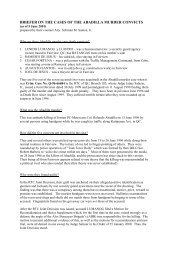Republic of the Philippines - Campaign
Republic of the Philippines - Campaign
Republic of the Philippines - Campaign
Create successful ePaper yourself
Turn your PDF publications into a flip-book with our unique Google optimized e-Paper software.
APPELLANTS’ BRIEF<br />
People <strong>of</strong> <strong>the</strong> <strong>Philippines</strong> vs. Fortuna, et. al.<br />
S. C. G. R. No. 141660-64<br />
uli ang suspect ng “BABA! … Walang makikialam.” … at sa takot ko ay dumapa ako sa<br />
guardhouse.”<br />
The phrase “sumigaw uli ang suspect,” in <strong>the</strong> answer to question # 17 means that<br />
<strong>the</strong> same person who earlier shouted at him shouted again when he did not heed <strong>the</strong><br />
command <strong>the</strong> first time it was given.<br />
When taken toge<strong>the</strong>r with <strong>the</strong> phrase “Isa sa suspect na nasa tapat ko ay tinutukan<br />
ako ng kanyang baril at sinigawan ako” in <strong>the</strong> answer to question # 16 <strong>the</strong> phrase<br />
“sumigaw uli ang suspect” proves that <strong>the</strong> witness was referring to one and <strong>the</strong> same<br />
person who shouted “BABA!” for <strong>the</strong> first time and who repeated <strong>the</strong> same command<br />
“BABA!” and added “Walang makikialam,” when he did not come down from <strong>the</strong><br />
guardhouse.<br />
Since <strong>the</strong> witness even qualified that <strong>the</strong> person who shouted at him was “isa sa<br />
suspect,” he could not have been referring to ano<strong>the</strong>r person o<strong>the</strong>r than <strong>the</strong> four suspects<br />
whom he saw around <strong>the</strong> victim’s car. O<strong>the</strong>rwise, if <strong>the</strong> suspect who pointed a gun at him<br />
was not among <strong>the</strong> four he saw around <strong>the</strong> victim’s car, he would have easily concluded<br />
that <strong>the</strong>re were five persons who perpetrated <strong>the</strong> act. But just five hours after <strong>the</strong> shooting<br />
incident, this witness freely and spontaneously narrated to <strong>the</strong> investigating <strong>of</strong>ficer that he<br />
saw four men shoot at <strong>the</strong> victim.<br />
It is also clear in his salaysay that when one <strong>of</strong> <strong>the</strong> suspects pointed a gun at him,<br />
he was nervous and could not move. In his own words, “Dahil sa nerbiyos ko ay hindi<br />
ako nakagalaw.” During his cross examination, however, <strong>the</strong> witness declared, “When<br />
only one suspect was pointing a gun at me, I wasn’t scared yet but when <strong>the</strong>re were<br />
already two suspects pointing a gun at me, I went down because <strong>the</strong>y might actually<br />
shoot me.” (TSN, September 4, 1996, p. 22)<br />
These discrepancies in <strong>the</strong> contents <strong>of</strong> <strong>the</strong> witness’ affidavit and his testimony in<br />
open court are important and substantial. Increasing <strong>the</strong> number <strong>of</strong> suspects from four to<br />
six significantly contradicts a material point that <strong>the</strong> witness stated in his affidavit.<br />
Page 37 <strong>of</strong> 127<br />
37




